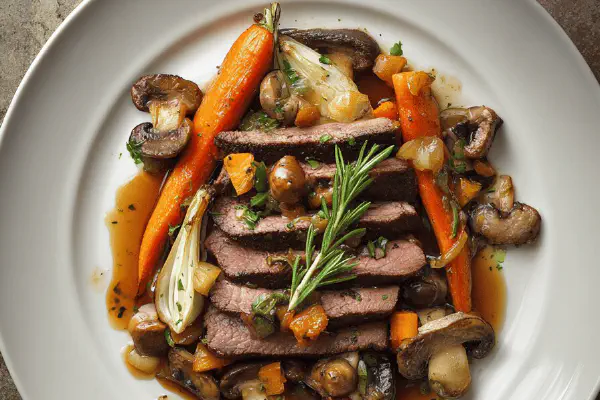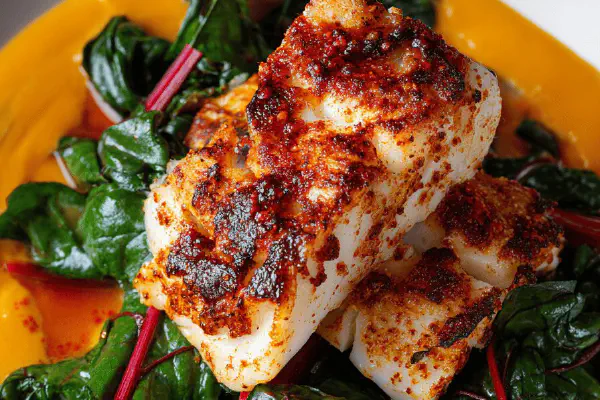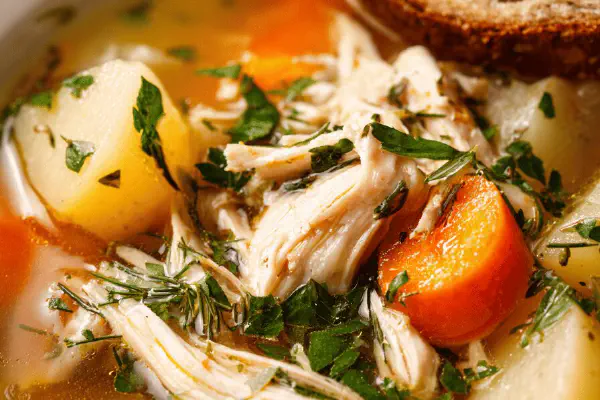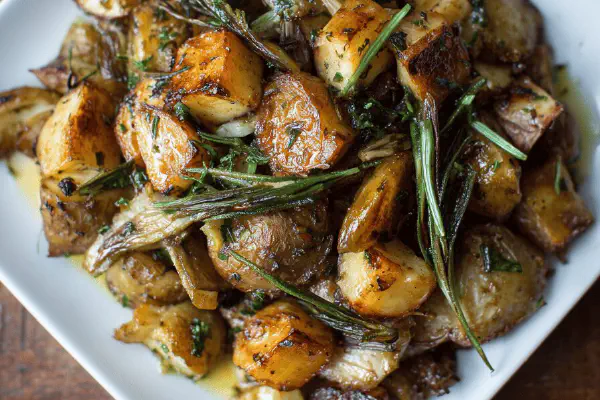Pork Bavette with Mushrooms Figs

By Emma
Certified Culinary Professional
Ingredients
- 600 g pork bavette (skirt steak)
- 50 ml red wine vinegar
- 75 ml olive oil
- 350 g mixed mushrooms (shiitake, oyster, white) quartered
- 1 large shallot sliced thin
- 200 ml chicken stock or water
- 5 dried apricots diced
- 1 bay leaf
- Salt and fresh cracked black pepper
About the ingredients
Method
- Start by placing pork in shallow glass dish; pour red wine vinegar over, sprinkle generous salt and pepper. Marinate 20 minutes in fridge; do not skip. Vinegar tenderizes and lifts flavor but doesn't need long.
- Remove pork; pat dry with paper towels. Keep marinade aside for sauce later. Heat half olive oil in heavy skillet over medium-high. When just smoking, lay pork flat. Listen to sizzle; sear 3-4 minutes each side until golden crust forms. Meat should spring back but with some give - too firm means overcooked. Remove and tent loosely with foil to rest.
- Same pan, reduce heat to medium, add rest of oil. Toss in shallots first; sweat until translucent and fragrant but not colored - about 3 minutes. Then mushrooms go in. Stir often, you want color, not soggy. Season with salt, pepper. When mushrooms shrink, edges crispy, pour in reserved marinade, chicken stock, and bay leaf.
- Add diced apricots. Simmer uncovered, stirring occasionally, till liquid reduces by half, becomes syrupy and rich, coating mushrooms. Should smell sweet, tangy, with hints of herbs. Taste for seasoning; add more pepper or salt if needed. Remove bay leaf before serving.
- Slice pork thinly against the grain – this is critical; otherwise tough fibers chew yucky. Plate meat, spoon mushroom-fig sauce over. Suggest roasted carrots, parsnips or sautéed greens as sides. Serve immediately to preserve juices and sauce texture.
Cooking tips
Chef's notes
- 💡 Marinate only 20 minutes maximum. Longer means mushy meat. Vinegar sharp enough to tenderize quickly; no soaking. Pat pork dry or steak won't sear, turns wet steam. Sizzle sound key; blue gray smoke tells oil too hot or burnt.
- 💡 Use split olive oil dose. Half for sear, high heat upfront, rest for gentle mushroom caramelization. Mushrooms not boiled in fat; need color edges before deglaze or they stay soggy. Stir often or edges burn unevenly.
- 💡 Listen closely during sear. Sharp sizzle fades, crust forms. Press meat lightly; spring back but slight give means correct doneness. Over-firm = dry. Rest loosely covered; tight foil traps steam ruining crust crispness.
- 💡 Apricots diced fine and last minute. Softness without dissolving into sauce. Bay leaf brings slow perfume, avoids sharp herb notes. Remove leaf before plating or stays too intense. Taste sauce mid reduction to balance salt pepper smartly.
- 💡 Slice thin across grain. Critical for tenderness. Grain runs lengthwise; follow texture lines with knife. Too thick slices chew hard. Meat juicy but fibers crisp snap. Serve meat warm with sauce shiny and thick, not watery or bitter.
Common questions
How long to marinate pork bavette?
Only 20 minutes. Vinegar sharp. Longer breaks down meat too much, mush risk. Shorter less tender, but safer texture. Keep in fridge always. No skipping - vinegar lifts flavor fast.
Can mushrooms be replaced?
Yes - shiitake and oyster best for meatiness, but white button adds volume if needed. Avoid watery types like cremini. Saute till edges dry, no boil. Adjust liquid if stock used or water for lighter flavor.
Sauce too thin how to fix?
Simmer longer uncovered. Stir occasionally. Reduce heat lower, slow thickening avoids burning vinegar taste. If stuck, add apricots last; they swell and help thicken naturally. Avoid adding flour or cornstarch sludge here.
Leftovers storage?
Cool fast. Store separately meat and sauce if possible. Refrigerate 3-4 days max. Reheat gentle, medium pan heat; no microwave steam unless covered loose. Sauce thickens cold, stir in splash water or stock when warming.



